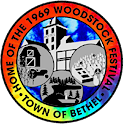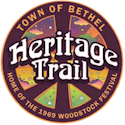Black Lake
The following is an excerpt from Rita J. Sheehan's Bethel, part of the Images of America series available from Arcadia Publishing
Black Lake was named for its dark and muddy waters by Horace Smith in approximately 1800. when he was exploring the wilderness south of White Lake and came across a hunter. Norman Judson, who was lost The Black Lake and White Lake Brooks were known by the Native Americans as Min-ga-pock. meaning "water abounding in fish:' At one time, the hamlet of Black Lake was named Forestine. William Knapp was the first settler at Black Lake. His brother, Walter, came five years later. William and Walter built the first sawmill there on land once owned by John K. Beekman. The mill was located at the outlet of Black Lake. The mill was transferred back to Beekman through William Knapp's debt and was rebuilt by Beekman in 1822. Beekman operated the mill until his death in 1841_ A large tannery was built there in 1849 by Mitchell and Strong. Medad T. Morse bought the tannery from Mitchell and Strong and continued tanning until the hemlock bark was used up. In 1872, the number of
inhabitants of Black Lake was 120. The Forestine Post Office opened on April 24, 1902, and closed on December 31, 1934. The Forestine School is located on Moscoe Road and was in operation from the early 1900s until the 1940s. The school is still in very good condition and today is used as a private residence.

The Black Lake falls were located at the edge of the sawmill. Black Lake is a hamlet situated at the outlet of the lake of the same name. two miles southwest of White Lake on the Black Lake Brook. named for its dark and muddy waters by Horace Smith while exploring the wilderness in approximately 1800. William Knapp was the first settler His brother Walter came five years later, (Courtesy of Chris Regan and Susannah Keagle.)
The first sawmill in Black Lake was built by William and his brother Walter. The Knapps came from Cornwall-on-Hudson. The mill was rebuilt in 1822 by John K. Beekman and was operated by him for nearly 20 years. It vas located at the outlet of Black Lake. The mill is shown here on the right. (Courtesy of John Gieger)


Loggers would float the fallen logs from Lake Superior through the outlet into Black Lake to the sawmill. The Black Lake Brook flows into Toronto Resevoir. Black Lake was owned by the Frys as early as 1900, (Courtesy of Art and Betty Fox of Iroquois Hunting and Fishing Club.)
The Forestine School, later known as the Black Lake School, operated from the 1860s until the 1940s Frieda Neuberger was the teacher from 1928 until 1934. There was a big container in the corner of the mom with a spigot for water that got filled to last all day. The school had inside bathrooms. Some of the other teachers were Frank Brown. ? Smith. and Dorothy Fry Schaefer.


The Forestine Post Office opened on April 24. 1902, with Samuel A. French as the postmaster Nelson French changed the name from Black Lake to Forestine. The post office was located on Route 55 near Dr. Duggan Road. It closed on December 31, 1934. This photograph is dated 1902. (Courtesy of Chris Regan and Susannah Keagle.)
The Sunset View Farm was a grand boardinghouse before it was the dance hall at Levine's Boarding House. This image is dated 1900. The carnage house stood until it burned New Years Day 1970. In 1934. the house had a tennis court and handball court. The Sunset View Farm is now a private residence owned by the Reeds. (Courtesy of Alfred and Maria Reed.)


Levine's Boarding House, pictured on the left, was run by Ida Levine. On the right is the carnage house. Ida and Leon Levine (son) would come up by train to Caihcoon then by carnage to Black Lake. Leon was born in 1899. They used to make their own electricity from a water mill and a windmill. it is located on the left side of Route 55 passed Dr. Duggan Road. (Courtesy of Alfred and Maria Reed.)
This is a Black Lake School reunion in 1986 at the Bethel Presbyterian Church. Seen here are. from left to right, (first row) Bertha Millen Baker (teacher, 1920-1921), Frieda Nueberger (teacher, 1928-1934), and Rita Vanetton Bairn (teacher, 1939-1944); (second row) Beulah Brucher MacArthur, Lillian Colo Cooney. Marcella Bracher. Doris Slater Haddock Hilda Brunning Rossal, Gertrude &licher Smith. Millie Dauch Middaugh, Irene LaPoIt, Lillian Brucker Phillips, Hilda Eldridge HA Selma Eldridge Kober, and Iva Eldridge Foster; (third tuw) ? Wagner. Mildred Phillips Bressler, Joan Dauch Keesier, Jim Phillips, Andrew V. LaPolt III, ? Gerow, and Ralph Phillips: (fourth row) John Wagner, John Kiiroin, Elmer "Shorty" Brucher, Ernest Brucher, Jack Mattison, Raymond Brucher, and Karl Brunning.

To read more you can purchase your copy of Rita J. Sheehan's Bethel, part of the Images of America series available from Arcadia Publishing





